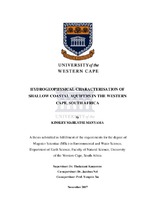| dc.description.abstract | Coastal aquifers present a key groundwater resource for freshwater supply in many
coastal zones of Africa, and its availability is largely driven by the physical
hydrogeological properties. An understanding of the aquifer properties in coastal
areas is fundamental in that these aquifers present unique resource largely
controlled to a very large extent by its geological and hydrological features and
process. This study thus analysed information of resistivity variation of formations,
drilling samples, water levels and slug test data, in an attempt to characterise
aquifers in the coastal region of the Heuningnes Catchment, Western Cape. This
was in an effort to address the issue of limited knowledge on key hydrogeological
properties of aquifers in coastal regions. Resistivity survey results indicated that the
shallow aquifers in the study area were limited in extent, had a poor potential, with
resistant layers occurring below shallow, high conductive formations. The long
profile of the wellpoints revealed that the area is underlain by various layers of
material of consolidated to unconsolidated form. The hard rocks formations are
overlain by sandy materials of fluvial origin, and clay material with marine deposits
(mollusc shells). This findings were in agreement with the results of the resistivity
models. In addition, the findings indicated that the saturation thickness of the
aquifers was also small. The findings of the study on aquifer properties indicated
that, hydraulic conductivity (K), transmissivity (T) and borehole yields were
generally poor and small. Estimates of K and T ranged from 0.0030 to 0.2856 m/day
and from 0.0008 to10.993 m2/day accordingly, while average borehole yields were
at 0.55 l/s, with productivity of the aquifers classified as low to moderate. These
were indicative of a low permeability environment, with low yielding formations.
An updated conceptual groundwater flow model developed in this study, revealed
a rather compacted groundwater flow systems, in which local and intermediate
flows were dominant. These findings in this study support the view that aquifers in
coastal regions were predominantly characterised by shallow depth, patchy
distribution and low potential. | |

